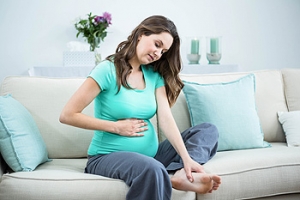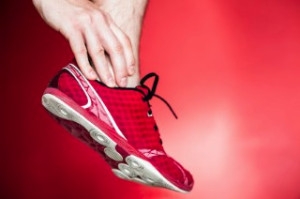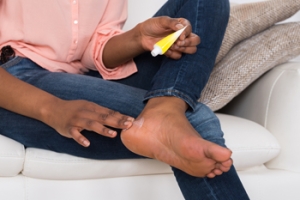Blog

Types of Corns
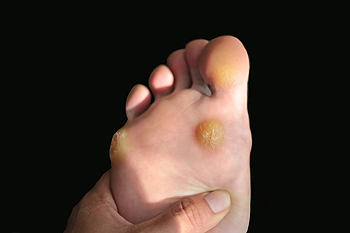 People who have experienced a corn on their feet are often aware of the pain and discomfort they can cause. Corns can develop between the toes, which are referred to as soft corns. The pain may be severe while walking in shoes, and mild relief may be found when it is covered by a corn pad. Corns are often caused by wearing shoes that do not fit correctly, and the corn may diminish when proper footwear is worn. Corns that develop on top of the toes are known as hard corns, and can form as a result of friction that comes from the top of the foot rubbing against the top of the shoe. Corns can cause pain that can affect the structure of the feet, which is why it is suggested that you consult with a podiatrist who can properly remove any corns you may have, and guide you toward proper prevention.
People who have experienced a corn on their feet are often aware of the pain and discomfort they can cause. Corns can develop between the toes, which are referred to as soft corns. The pain may be severe while walking in shoes, and mild relief may be found when it is covered by a corn pad. Corns are often caused by wearing shoes that do not fit correctly, and the corn may diminish when proper footwear is worn. Corns that develop on top of the toes are known as hard corns, and can form as a result of friction that comes from the top of the foot rubbing against the top of the shoe. Corns can cause pain that can affect the structure of the feet, which is why it is suggested that you consult with a podiatrist who can properly remove any corns you may have, and guide you toward proper prevention.
If you have any concerns regarding your feet and ankles, contact Dr. Dean D. Hinners of Illinois. Our doctor will treat your foot and ankle needs.
Corns: What Are They? and How Do You Get Rid of Them?
Corns can be described as areas of the skin that have thickened to the point of becoming painful or irritating. They are often layers and layers of the skin that have become dry and rough, and are normally smaller than calluses.
Ways to Prevent Corns
There are many ways to get rid of painful corns such as wearing:
- Well-fitting socks
- Comfortable shoes that are not tight around your foot
- Shoes that offer support
Treating Corns
Treatment of corns involves removing the dead skin that has built up in the specific area of the foot. Consult with Our doctor to determine the best treatment option for your case of corns.
If you have any questions please feel free to contact one of our offices located in Metropolis and Eldorado, IL . We offer the newest diagnostic and treatment technologies for all your foot and ankle needs.
Everything You Need to Know About Corns
Corns are hard and thick areas of skin that form as a result of constant rubbing, friction, or pressure on the skin. They are patches of dead skin with a small plug toward the center. They may appear on the tops and sides of toes and can make walking painful.
Soft corns are typically thinner with a white color and rubbery texture. Soft corns tend to appear between the toes. Seed corns are another type of corn that appear in clusters and can be tender if they are on a weight-bearing part of the foot. Seed corns usually appear on the bottom of the foot and are likely caused by a blockage in sweat ducts.
While corns and calluses are somewhat similar, calluses are a bit different. Calluses are a patch of dead skin that can occur anywhere on the body. In comparison to corns, calluses are usually a bit larger in size. However, both corns and calluses are caused by increased friction on the skin.
There are some risk factors that may increase your chances of developing corns and calluses. If you have bunions, hammertoe, or a bone spur, you are more likely to develop a corn or callus on your foot.
While Corns and Calluses tend to disappear when the friction to the affected area ceases, the help of a podiatrist may be useful in the removal process. It is important to remove the dead skin around the area and this may be done in a few different ways. Moisturizing creams may be helpful in softening and removing the dead skin around the callus. You should never use razors or other pedicure equipment to remove your corns. Doing this may worsen your corn or callus and cause infection.
In some cases, corns and calluses may be caused by abnormal foot structure or walking motion. In such a case, you should seek a podiatrist’s assistance in order to correct the issue.
Flatfoot
Flatfoot is a foot disorder that is not as straightforward as many people believe. Various types of flatfoot exist, each with their own varying deformities and symptoms. The partial or total collapse of the arch, however, is a characteristic common to all types of flatfoot. Other signs of flatfoot include:
- “Toe drift,” or the pointing outward of the toes and the front part of the foot
- The tilting outward of the heel and the tilting inward of the ankle
- The lifting of the heel off the ground earlier when walking due to a tight Achilles tendon
- Hammertoes
- Bunions
One of the most common types of flatfoot is flexible flatfoot. This variation usually starts in childhood and progresses as one ages into adulthood. Flexible flatfoot presents as a foot that is flat when standing, or weight-bearing. When not standing, the arch returns. Symptoms of flexible flatfoot include:
- Pain located in the heel, arch, ankle, or along the outside of the foot
- Overpronation, or an ankle that rolls in
- Shin splint, or pain along the shin bone
- General foot aches or fatigue
- Pain located in the lower back, hip, or knee
Your podiatrist will most likely diagnose flatfoot by examining your feet when you stand and sit. X-rays may be taken to define the severity and help determine the treatment option best for your condition. Nonsurgical treatments can include activity modification, weight loss, orthotics, immobilization, medications, physical therapy, shoe modifications, and ankle foot orthoses (AFO) devices. If nonsurgical methods prove ineffective, surgery may be considered. Multiple surgical procedures can correct flatfoot; and depending on your specific condition, one may be selected alone or combined with other techniques to ensure optimal results.
Possible Causes of Foot Pain During Pregnancy
 Many women can experience foot pain at some point in their pregnancy. It is a common ailment, and may be caused by hormonal changes, in addition to the increasing weight the feet must bear from the growing fetus. Swollen feet, cramping, and general achiness are frequent complaints of pregnant women, which may cause difficulty in completing daily activities. It may help to elevate the feet as often as possible, as this may bring mild relief to any existing swelling. Additionally, implementing a healthy lifestyle that includes eating fresh vegetables and drinking plenty of water may help to control swollen feet as well. Many pregnant women enjoy foot massages, which may help to improve circulation. If you would like more information about how to keep your feet healthy during your pregnancy, please consult with a podiatrist who can offer you helpful words of advice.
Many women can experience foot pain at some point in their pregnancy. It is a common ailment, and may be caused by hormonal changes, in addition to the increasing weight the feet must bear from the growing fetus. Swollen feet, cramping, and general achiness are frequent complaints of pregnant women, which may cause difficulty in completing daily activities. It may help to elevate the feet as often as possible, as this may bring mild relief to any existing swelling. Additionally, implementing a healthy lifestyle that includes eating fresh vegetables and drinking plenty of water may help to control swollen feet as well. Many pregnant women enjoy foot massages, which may help to improve circulation. If you would like more information about how to keep your feet healthy during your pregnancy, please consult with a podiatrist who can offer you helpful words of advice.
Pregnant women with swollen feet can be treated with a variety of different methods that are readily available. For more information about other cures for swollen feet during pregnancy, consult with Dr. Dean D. Hinners from Illinois. Our doctor will attend to all of your foot and ankle needs.
What Foot Problems Can Arise During Pregnancy?
One problem that can occur is overpronation, which occurs when the arch of the foot flattens and tends to roll inward. This can cause pain and discomfort in your heels while you’re walking or even just standing up, trying to support your baby.
Another problem is edema, or swelling in the extremities. This often affects the feet during pregnancy but tends to occur in the later stages.
How Can I Keep My Feet Healthy During Pregnancy?
- Wearing orthotics can provide extra support for the feet and help distribute weight evenly
- Minimize the amount of time spent walking barefoot
- Wear shoes with good arch support
- Wear shoes that allow for good circulation to the feet
- Elevate feet if you experience swelling
- Massage your feet
- Get regular, light exercise, such as walking, to promote blood circulation to the feet
If you have any questions please feel free to contact one of our offices located in Metropolis and Eldorado, IL . We offer the newest diagnostic and treatment technologies for all your foot and ankle needs.
Foot Care for Pregnant Women
The natural weight that pregnant women gain causes their center of gravity to be completely altered. This causes them to have a new weight-bearing stance which adds pressure to the knees and feet. As a result, pregnant women often experience severe foot pain. The two most common foot issues experienced by women in their pregnancies are edema and over-pronation. It is important for all pregnant women to learn more about how to take care of their feet so they are more comfortable during their pregnancy.
Over-pronation, which is commonly referred to as flat feet, is caused when a person’s arch flattens out upon weight bearing. This causes the person’s feet to roll inward while walking. Pregnant women often experience this due to the sudden weight they gain.
Edema, also referred as swelling in the feet, typically occurs in the later part of the pregnancy. It is the result of the extra blood accumulated in the pregnant woman’s body. The enlarged uterus puts more pressure on the blood vessels in the pelvis which causes leg circulation to slow down. This causes blood to pool in the lower extremities.
Fortunately, there are ways to treat both edema and over-pronation. Edema can be treated by elevating the foot as often as possible. Wearing proper fitting footwear will also be helpful for those with edema. A treatment method for over-pronation could be orthotics. Orthotic inserts should be designed with appropriate arch support and medial rear foot for your foot.
It is best for pregnant women to buy new shoes during the day, because this is the time where swelling is at its peak. Pregnant women also shouldn’t rush when buying shoes. It is always advised that you make sure your shoes fit properly but this is especially important during pregnancy.
If you are a pregnant woman, you should consult with a podiatrist in order to make sure your feet are healthy throughout the entirety of your pregnancy.
Running vs. Walking Shoes
 Whether you are a runner or a walker, the shoes that you exercise in should fit your needs. Stores tend to carry more running shoes than walking shoes, and while a runner shouldn't run in walking shoes, a walker may certainly walk in running shoes. That may sound slightly confusing, but the bottom line is that both runners and walkers can benefit from wearing running shoes while exercising as long as they buy shoes that fit their specific activity. Runners should buy shoes that have more cushioning in the heel and forefoot, while walkers generally don’t need extra cushioning in the forefoot and should opt for something more lightweight. Runners need shoes with a higher difference in height from the heel through the toe called the heel drop, while walkers should choose shoes with a heel drop of less than 8 millimeters. For more information on finding the best footwear for your needs, consult with a podiatrist.
Whether you are a runner or a walker, the shoes that you exercise in should fit your needs. Stores tend to carry more running shoes than walking shoes, and while a runner shouldn't run in walking shoes, a walker may certainly walk in running shoes. That may sound slightly confusing, but the bottom line is that both runners and walkers can benefit from wearing running shoes while exercising as long as they buy shoes that fit their specific activity. Runners should buy shoes that have more cushioning in the heel and forefoot, while walkers generally don’t need extra cushioning in the forefoot and should opt for something more lightweight. Runners need shoes with a higher difference in height from the heel through the toe called the heel drop, while walkers should choose shoes with a heel drop of less than 8 millimeters. For more information on finding the best footwear for your needs, consult with a podiatrist.
For more information about walking shoes versus running shoes, consult with Dr. Dean D. Hinners from Illinois. Our doctor can measure your feet to determine what your needs are and help you find an appropriate pair of footwear.
Foot Health: The Differences between Walking & Running Shoes
There are great ways to stay in shape: running and walking are two great exercises to a healthy lifestyle. It is important to know that running shoes and walking shoes are not interchangeable. There is a key difference on how the feet hit the ground when someone is running or walking. This is why one should be aware that a shoe is designed differently for each activity.
You may be asking yourself what the real differences are between walking and running shoes and the answers may shock you.
Differences
Walking doesn’t involve as much stress or impact on the feet as running does. However, this doesn’t mean that you should be any less prepared. When you’re walking, you land on your heels and have your foot roll forward. This rolling motion requires additional support to the feet.
Flexibility – Walking shoes are designed to have soft, flexible soles. This allows the walker to push off easily with each step.
If you have any questions, please feel free to contact one of our offices located in Metropolis and Eldorado, IL . We offer the newest diagnostic and treatment technologies for all your foot care needs.
Walking Shoes vs. Running Shoes
Although walking shoes and running shoes look similar, they have characteristics that make them different from each other. Runners should avoid running in walking shoes and vice versa. It is very important that you wear the proper footwear for the activity you are going to partake in, for you to avoid injury.
If you are looking to buy a new pair of running shoes, there are certain things you should look out for. One of the main components that makes up a good running shoe is flexibility. You should be able to bend and flex the forefoot of the shoe that you are purchasing. If you can bend the entire shoe in half with ease, this is a sign that the shoe does not have enough structure for your feet. Another feature you should look for is a low heel. Certain running shoes have a low heel to support runners who land on the ball of their feet. Lastly, you should look for the fit of the running shoe. You should visit the best running shoe store in your area to have your feet properly sized for the shoes in the store. Usually, the staff will be able to help recommend the best type of running shoe for your needs.
When you are walking, the body’s weight is evenly distributed on the foot. This influences the design of shoes made for walking. If you are looking to buy a pair of walking shoes, there are different features you should look for to determine which pair of shoes is best for you. Walking shoes should be flexible through the ball of the foot to allow for a greater range of motion through the roll of the forefoot. These shoes also should have greater arch support for the foot. If you plan on walking long distances or on hard surfaces, it is best that you wear shoes that have cushioning.
When trying on a new pair of shoes, the heel should fit snugly without slip. You should shop for shoes after a long walk, since your feet tend to swell throughout the day. Many people have one foot that is a different size than the other, so it is best that you have both feet measured when looking for your true size. You should also beware that sizes vary depending on the shoe brand. A certain size in one brand may be a different size in a different brand. Lastly, you should always walk around in shoes that you plan on buying. This will help you determine whether the shoes are comfortable and if they fit well on your feet.
Always look for good shoe construction when shopping for new sneakers. The upper part of the shoe should allow for adjustment through laces or straps. If you need help with shoe sizing or if you need custom orthotics for your feet, you should make an appointment with your podiatrist for assistance. He or she will be more than happy to help you with your shoe sizing needs.
How Can I Prevent Cracked Heels?
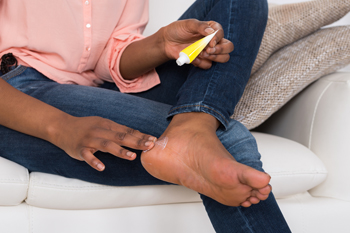 Cracked heels can have a variety of causes. It is believed that intense pressure or friction on the feet is the primary cause of cracked heels, however, they may also come about as a result of not moisturizing your feet regularly, taking overly long, hot showers, using harsh soaps, harsh weather conditions, wearing shoes that have open backs or thin soles, and wearing poorly fitted high heels. One home treatment for cracked heels is applying a thick layer of moisturizer to your feet after a shower or bath and then putting on a pair of cotton socks. To prevent cracked heels, it is suggested that you avoid harsh soaps and scrubbing your feet, and that you wear supportive shoes and breathable socks to reduce friction. For more information on how to prevent and treat cracked heels, consult with a podiatrist today.
Cracked heels can have a variety of causes. It is believed that intense pressure or friction on the feet is the primary cause of cracked heels, however, they may also come about as a result of not moisturizing your feet regularly, taking overly long, hot showers, using harsh soaps, harsh weather conditions, wearing shoes that have open backs or thin soles, and wearing poorly fitted high heels. One home treatment for cracked heels is applying a thick layer of moisturizer to your feet after a shower or bath and then putting on a pair of cotton socks. To prevent cracked heels, it is suggested that you avoid harsh soaps and scrubbing your feet, and that you wear supportive shoes and breathable socks to reduce friction. For more information on how to prevent and treat cracked heels, consult with a podiatrist today.
If the skin on your feet starts to crack, you may want to see a podiatrist to find treatment. If you have any concerns, contact Dr. Dean D. Hinners from Illinois. Our doctor can provide the care you need to keep you pain-free and on your feet.
Cracked Heels
It is important to moisturize your cracked heels in order to prevent pain, bleeding, and infection. The reason cracked heels form is because the skin on the foot is too dry to support the immense pressure placed on them. When the foot expands, the dry skin on the foot begins to split.
Ways to Help Heal Them
- Invest in a good foot cream
- Try Using Petroleum Jelly
- Ease up on Soaps
- Drink Plenty of Water
Ways to Prevent Cracked Heels
- Moisturize After Showering
- Skip a Shower
- Keep Shower Water Lukewarm
- Don’t Scrub Your Feet
If you are unsure how to proceed in treating cracked heels, seek guidance from a podiatrist. Your doctor will help you with any questions or information you may need.
If you have any questions, please feel free to contact one of our offices located in Metropolis and Eldorado, IL . We offer the newest diagnostic and treatment technologies for all your foot care needs.
Solutions for Cracked Heels
Cracked heels can make life very frustrating and embarrassing when displaying the bare feet. Aside from being unpleasing to the eye, they can also tear stockings and socks and wear out shoes at a faster rate. When severe, cracked heels may cause pain or infection.
Cracked heels are a problem for those who are athletic, those who may walk a lot, and those who have especially dry skin. Those who use medication that dry the skin, those who swim often, wearing certain types of shoes, and those who are diabetic may have trouble with cracked heels. Seniors whose skin produces less oil may also have trouble with cracked feet. There is no one way to develop cracked feet, and there is no cure.
Today, the market consists of numerous products that have a variety of ingredients to promote healing. Some of these are over-the-counter. Others are prescribed by a doctor, especially for those who have chronic dry feet and heels.
Some doctors recommend wearing socks at night for those with rough skin. This helps further healing, and helps creams stay on longer and better absorb into the skin.
One way to alleviate dryness that causes cracked heels is by using moisturizers both day and night. Another way is to make sure the skin is clean and dry at all times. Using a pumice stone to buff away dead skin before putting on moisturizer can also help. Cracked heels will not respond to the cream unless the outer layer of skin is first removed through exfoliation. After exfoliation, lotion or ointment will be absorbed by the skin more easily.
Foods that produce healing and balance can also help the skin from within. Everything that is put into the body can either help it or hurt it. Taking supplements of omega-3 fatty acids and zinc can also be very beneficial.
Nevertheless, not all products are guaranteed to help treat cracked feet. Seeing a professional is best if other treatments options were unsuccessful. A podiatrist should be able to give the best advice to help with this problem.

